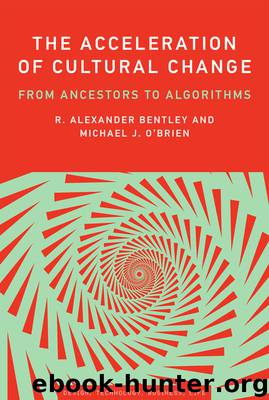The Acceleration of Cultural Change by R. Alexander Bentley & Michael O'Brien

Author:R. Alexander Bentley & Michael O'Brien
Language: eng
Format: epub
Tags: evolution; cultural anthropology; business; evolutionary psychology; culture; theory; social sciences; information; sociology; cultural inheritance; archaeology; transmission; AI; artificial intelligence
Publisher: The MIT Press
Published: 2017-09-29T04:00:00+00:00
If monogamy and nuclear families, never universal among the world’s societies, arose as adaptive cultural traditions, they have since needed to be actively maintained. In Europe, where patriliny is thousands of years old, extra-pair paternity (cheating) has averaged only about 1 to 2 percent per generation during the last four hundred years, according to a study of Y chromosomal data. Similarly, genetic tests in Mali showed extra-pair paternity rates of only 1 to 3 percent among the Dogon. For Dogon women, who viewed menstrual blood as dangerous and polluting, monogamy was ensured by monthly seclusion inside an isolated menstrual hut for several uncomfortable nights. After a woman gave birth, she had to revisit the menstrual hut, and the husband’s patrilineage made sure that she slept only with the husband.
The economy of marriages offers explanation for change. Looking through the 2002 census of Uganda, evolutionary anthropologists Thomas Pollet and Daniel Nettle found a supply-and-demand effect: polygynous marriages were more common in districts where women outnumbered men. They also found that polygynously married men owned more land than monogamous ones. In agrarian and pastoralist societies, more land means families need more children as sources of free labor, and children are viewed as wealth.
Fertility is declining, though, in wealthy developed societies, where family economics have been reversed. In a knowledge economy, fewer children mean more wealth to invest in their education. In an age when four years of college costs as much as a house, and many top jobs require further graduate training, the economic choice may be for no children at all. The “DINK” bumper sticker on that Mercedes SL passing you at eighty-five miles per hour sums it up: “Dual Income, No Kids.” Compare the household economics of two generations—millennials on short-term contracts, living with parents in dormitory-style complexes, versus baby boomers with long-term jobs and houses that have increased in value twentyfold since the 1970s—and the decline in marriage rates makes sense.
Download
This site does not store any files on its server. We only index and link to content provided by other sites. Please contact the content providers to delete copyright contents if any and email us, we'll remove relevant links or contents immediately.
Rewire Your Anxious Brain by Catherine M. Pittman(18533)
Talking to Strangers by Malcolm Gladwell(13194)
The Art of Thinking Clearly by Rolf Dobelli(10178)
Mindhunter: Inside the FBI's Elite Serial Crime Unit by John E. Douglas & Mark Olshaker(9164)
Becoming Supernatural by Dr. Joe Dispenza(8093)
Change Your Questions, Change Your Life by Marilee Adams(7610)
Nudge - Improving Decisions about Health, Wealth, and Happiness by Thaler Sunstein(7550)
The Road Less Traveled by M. Scott Peck(7506)
The Lost Art of Listening by Michael P. Nichols(7388)
Mastermind: How to Think Like Sherlock Holmes by Maria Konnikova(7197)
Enlightenment Now: The Case for Reason, Science, Humanism, and Progress by Steven Pinker(7169)
Win Bigly by Scott Adams(7078)
The Way of Zen by Alan W. Watts(6482)
Daring Greatly by Brene Brown(6429)
Big Magic: Creative Living Beyond Fear by Elizabeth Gilbert(5578)
Grit by Angela Duckworth(5497)
Ego Is the Enemy by Ryan Holiday(5268)
Men In Love by Nancy Friday(5139)
Altered Sensations by David Pantalony(5030)
